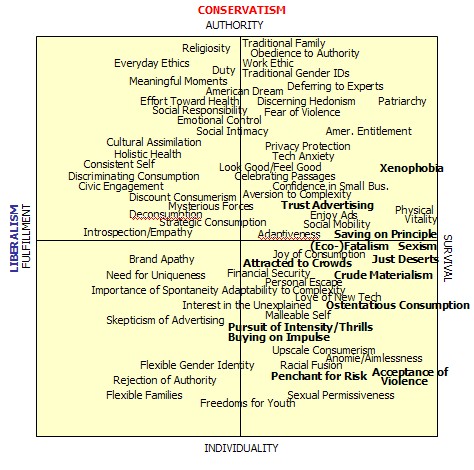
[On the chart above, 110 values surveyed by pollster Michael Adams are plotted according to where they fall on a 2-by-2 grid. The values that (per the survey) have become significantly more prevalent in Americans since 1992 are shown in bold. An acceptance of violence as inevitable, persuasive and cathartic showed the greatest increase of any of the 110 values. There has been a commensurate drop in the proportion of respondents holding many of the values that both conservatives and progressives hold dear (those in the upper left quadrant).]

[This chart shows the median position of people in different demographics on the same values map. Note particularly the median values for young Americans. The survey found a growing proportion of Americans disengaged, disenchanted, and fatalistic, but this small plurality is especially pronounced in young Americans of all stripes, races, regions and economic backgrounds.]
On the ferry home the other day I overheard three attractive, well-dressed teenagers (I’d guess 16-17 years old), one male and two females, engaged in one of the most disturbing conversations I’ve ever witnessed. The conversation had three threads, if you could call them that:
- Bragging about their theft of people’s umbrellas, just for fun. Explaining that when the owner of the umbrella saw them stealing it and shouted that it was theirs, they would just shout back scornfully that they knew it was, and run away. Discussing that if they saw a cop they would just drop the umbrella and run.
- Identifying and making fun of shy, unattractive and poorly-dressed kids in their class. Listing what was “pathetic” about each.
- Engaging each other in sexual bravado. Example: When one of the girls asked the boy, as he was heading to the bathroom, why he cared about a certain issue, he called back (without looking back) “Because I want to fuck you.” The girls looked at each other, and then laughed. They all agreed they wouldn’t be able to function in a world where gender roles were reversed, “where the girls were the more aggressive and the guys had to dress provocatively and wait to be invited out.”
This reminded me of an experience I had last year where a group of us in a restaurant witnessed two young (perhaps underage) girls at the bar draped all over two fat, ugly old bikers, kissing them and sucking up to everything they said. My colleagues said at the time that they weren’t as surprised as I was, and that the girls were probably not prostitutes, just “kids” impressed by the machines and the freedom of their riders.
I don’t know why these occurrences had such a strong, negative effect on me. Maybe I live in a different world from most people, and I’m just very fortunate to have lived a gentler life than most. Mostly, they left me with a bunch of unanswered questions:
- Is the ferry conversation evidence of young people’s way of desensitizing themselves to the emotional assaults of the modern world? Are they trying to teach themselves not to care so much?
- Is this a new phenomenon, or has it always been this way (just because I wasn’t aware of it when I was young doesn’t mean it didn’t happen)? The charts above from recent surveys suggest it is new, and worsening, reflecting a growing anomie and fatalism especially among the young of both genders.
- How much can we attribute this behaviour to (a) media portrayal of sex and violence, (b) teenagers’ lack of interaction with people outside their immediate peer group (i.e. no mentors with more empathetic, responsible values), (c) the unconscious realization that the world is fucked and the situation is going to get increasingly worse?
- Are these behaviours and values pernicious? Will they be “outgrown”? Can they be changed, and if so, how? If not, what does this value set suggest will happen when this age cohort has to face an extended cascading series of economic, energy and ecological crises?
The book The Fourth Turning has, compared to the Adams surveys, a more charitable view of Generation Millennium (“obedient and conforming”, “team players”, “accepting of authority”, “upbeat”, “hard-working” and “self-censoring”). That view fits better with the impression I have of the teenagers and university students I know. But perhaps I really don’t know what most people are like at all.





Hello there Dave,
In The Netherlands a long-term survey charting the value patterns of people aged 15 to 80, results show that there is a significant and structural change in values and outlook within the generation born after 1986 and older generations. The researchers suggest that this change is caused by the way these youngsters have been raised by parents (who in a sense refuse to grow up themselves because they would rather stay young forever) and by our culture in general. The outlook of young people is that which evidently is being asked from them by our society.
Pingback: Tweets that mention Inured to Pain? « how to save the world -- Topsy.com
As a teen, I have to say that the teens you came across were immature and not at all self-aware. Evenso, they are just kids and they’ll likely grow out of some of it. Though, I doubt they’ll ever grow out of their need for certain gender roles.
As for the boys statement of “sexual bravado”, I don’t see the problem. It was frank, but not vulgar. That type of thing is usually said as a joke and a veiled attempt (flirting, actually) to open a much more subtle and often bashful dialogue as to whether the two people would be interested in a relationship.